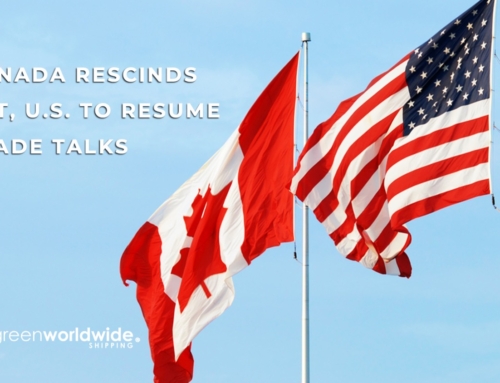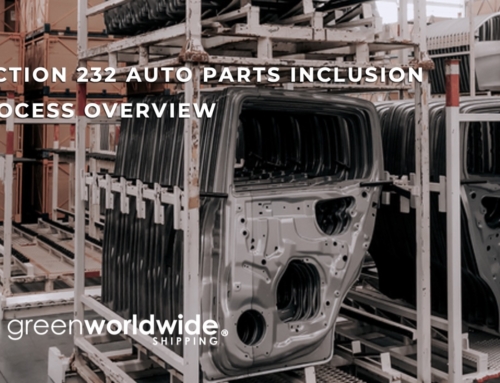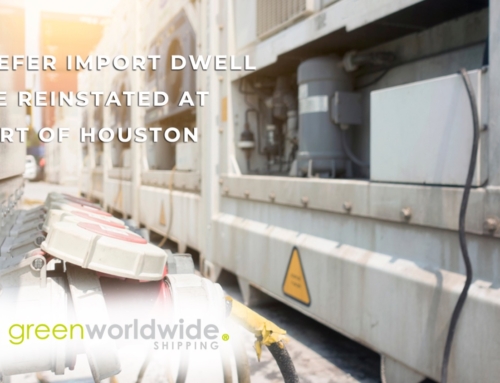Service contract season is just around the corner, and international shippers are asking themselves the age-old question, “are direct carrier contracts right for us?”
Chances are, you’ve either hedged your bets by pairing with an NVOCC for flexibility, or are still weighing the advantages of fixed, annual pricing with a steamship line.
Regardless of preference, every importer and exporter should understand these five major trends impacting the freight market, right now:
mega-capacity
As detailed in Green’s 2018 Freight Market Outlook, this year, shippers will finally see full-scale deployment of new, mega-vessels (carrying up to 22,000 TEU) to Asia-Europe routes. When doing so, medium-sized ships (carrying capacity of 10,000 – 14,000 TEU) are cycled into trans-Pacific and trans-Atlantic lanes, made possible by the expansion of the Panama Canal in 2016 and raising of the Bayonne Bridge to allow full access to NJ/New York ports.
But buying larger vessels, doesn’t come with automatic cost-savings for carriers; each vessel must have at least 80% utilization – a tricky balance between demand and supply that steamship lines have not quite mastered.
The last quarter of 2017 saw spot rates dip below contract levels as carriers injected too much capacity and stagnated typical peak season performance. Factor in shipping alliances (carrier agreements to share space on each other’s vessels), and the formula becomes even more complex.
When signing a direct contract, shippers should understand the alliance they are buying into, price-based slot competition during peak (think, your competitor paying $50/can more gets loaded, you get rolled), and spot vs. fixed pricing.
demand
Consumer demand is strong and predicted to increase 5-6% in 2018, primarily during the first half of the year.
Why is the time-frame so important? Because it’s when carriers will be trying to figure out their demand and supply formula to reach operational-savings on those new, shiny mega-vessels. More of an art than a science, steamship lines will have to account for the added complexity of alliance-based cooperation and mixed past performance.
And if capacity outstrips demand, we see results like those from 2017’s peak holiday season, during which vessel utilization was 6.9% lower year-over-year, as carriers failed to sufficiently compensate excess capacity with blank sailings.
The result? Shippers saw spot rates fall significantly (in some cases over $500/TEU) below contracted April pricing. Consider factoring in your industry’s heavy shipping periods to take advantage of a soft, buyer’s market.
chassis
Infrastructure upgrades, increased demand, inclement weather, and price fluctuations have all contributed to shift U.S. port volumes – and in doing so, stretched local chassis pools thin.
Chassis, the base-frame and wheels of a truck (excluding driver cab), are picked-up outside of the actual port, meaning more stops and less deliveries per driver. Adding to the frustration, mega-vessels depositing more containers at each port creates more congestion, and a mad scramble for chassis. If equipment is not available at local distributors, truckers must wait or delay deliveries, adding significant costs, that are ultimately, passed on to the shipper.
Shifting to alternative ports or rail options can give importers and exporters more flexibility, but in doing so, still creates skewed long-term chassis availability in those routings.
trucking shortage
Long wait-times, port traffic, increasing regulation, and lack-luster pay. Sounds enticing, right? This is the reality port trucking companies are facing trying to recruit new talent to replace a quickly aging work-force and fill a 50,000-driver shortage, that is only growing.
The majority of active truckers typically function as owner-operators, allowing them flexibility to choose longer, more profitable runs. Newly recruited drivers are left with shorter, complex deliveries that don’t turn around quickly enough at the ports.
Some independent operators are making the choice to simply sell and retire, proving that administrative limitations, such as the new electronic logging device (ELD) mandate, have direct impact on domestic carrier profitability.
electronic logging devices
Spurring the most controversy, the electronic logging device mandate, implemented in December 2017, has placed trucking hours-of-service (HOS) under a microscope.
Initially brushed off as low-impact, the regulation has shifted trucker capacity, frustrating shippers that fail to understand the impact these new restrictions have on their deliveries.
Founded to combat falsified hours-of-service resulting in on-road accidents and fatalities, ELDs synchronize with a vehicle’s engine for automated compliance. Starting April 1, 2018, drivers exceeding HOS rules will be pulled off the road and penalized.
Truckers have always faced pressures from shippers, forwarders, and carriers alike to stretch capacity of overworked drivers. Waiting an extra half hour to unload, could mean the difference between single and multiple runs, bringing the conversation back to capacity and the severe delays shippers are experiencing today.
moral of the story?
- Don’t get cornered. Always have alternative routing options available;
- Choose shipping options that align with market capacity and demand;
- Evaluate product lead-times to reduce delivery pressures;
- Buffer in extra time at the port for the perfect chassis;
- Don’t delay port truckers, they need to keep freight moving for everyone.






